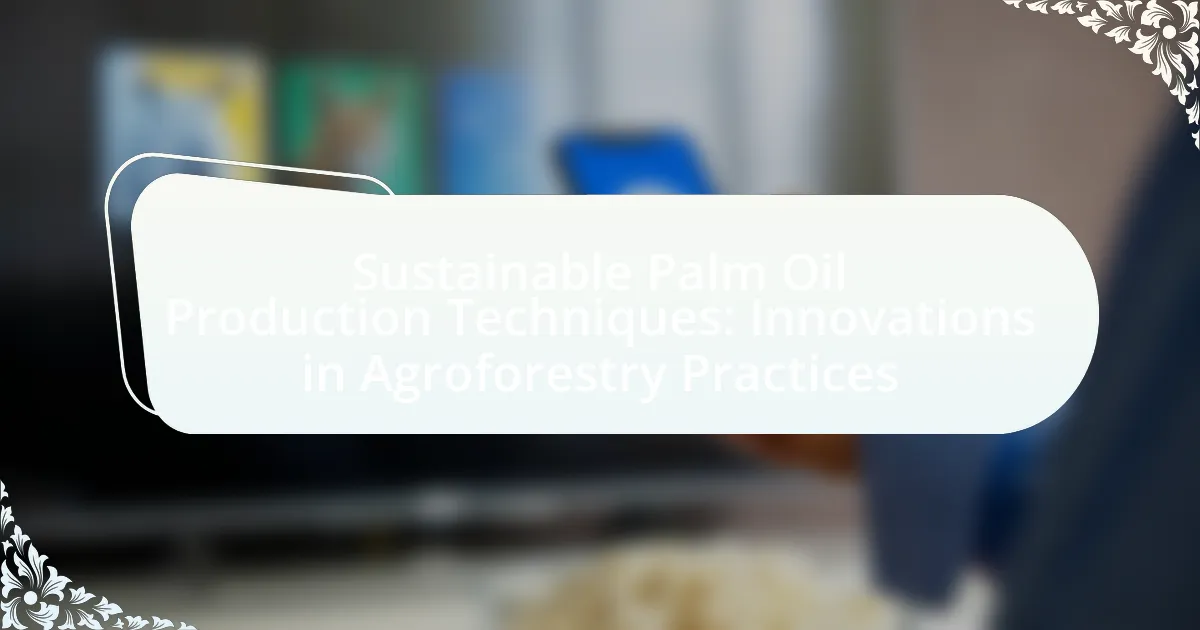Sustainable palm oil production techniques focus on innovative agroforestry practices that enhance biodiversity, improve soil health, and reduce reliance on chemical inputs. Key methods include intercropping, cover cropping, and maintaining buffer zones, which collectively contribute to environmental sustainability by mitigating deforestation and promoting responsible land management. The article outlines the principles of sustainable palm oil production, the role of local communities, and the challenges faced, such as economic viability and social equity. Additionally, it highlights the importance of certification programs and technological advancements in promoting sustainable practices within the palm oil industry.

What are Sustainable Palm Oil Production Techniques?
Sustainable palm oil production techniques include agroforestry practices, intercropping, and the use of cover crops. These methods enhance biodiversity, improve soil health, and reduce the need for chemical fertilizers and pesticides. For instance, integrating palm oil cultivation with other crops can lead to increased yields and reduced environmental impact, as demonstrated by studies showing that agroforestry systems can increase overall farm productivity by up to 30%. Additionally, practices such as maintaining buffer zones around water bodies and implementing sustainable land management strategies help mitigate deforestation and habitat loss, further supporting the sustainability of palm oil production.
How do these techniques contribute to environmental sustainability?
Sustainable palm oil production techniques, particularly innovations in agroforestry practices, contribute to environmental sustainability by enhancing biodiversity and reducing deforestation. These techniques integrate palm oil cultivation with other crops and trees, which promotes a diverse ecosystem that supports wildlife and improves soil health. Research indicates that agroforestry systems can increase carbon sequestration by up to 30% compared to monoculture plantations, thereby mitigating climate change. Additionally, these practices reduce the need for chemical fertilizers and pesticides, leading to lower pollution levels in surrounding environments.
What are the key principles of sustainable palm oil production?
The key principles of sustainable palm oil production include environmental protection, social responsibility, and economic viability. Environmental protection focuses on minimizing deforestation, preserving biodiversity, and reducing greenhouse gas emissions associated with palm oil cultivation. Social responsibility emphasizes fair labor practices, respect for indigenous rights, and community engagement. Economic viability ensures that palm oil production is profitable while maintaining sustainable practices. These principles are supported by frameworks such as the Roundtable on Sustainable Palm Oil (RSPO), which sets standards for sustainable practices and promotes transparency in the supply chain.
How do sustainable practices reduce deforestation?
Sustainable practices reduce deforestation by promoting land-use methods that balance agricultural productivity with environmental conservation. Techniques such as agroforestry, which integrates trees with crops, enhance biodiversity and soil health while minimizing the need for land clearing. Research indicates that implementing sustainable palm oil production methods can lead to a 50% reduction in deforestation rates compared to conventional practices, as evidenced by the Roundtable on Sustainable Palm Oil’s standards that encourage responsible land management and forest preservation.
Why is agroforestry important in palm oil production?
Agroforestry is important in palm oil production because it enhances biodiversity, improves soil health, and increases resilience against climate change. By integrating trees with palm oil plantations, agroforestry systems create habitats for various species, which can lead to improved pest control and pollination. Additionally, the presence of trees helps to prevent soil erosion and maintain soil fertility through organic matter contributions. Research indicates that agroforestry can increase yields by up to 30% compared to monoculture systems, demonstrating its effectiveness in promoting sustainable palm oil production.
What are the benefits of integrating agroforestry with palm oil cultivation?
Integrating agroforestry with palm oil cultivation enhances biodiversity, improves soil health, and increases economic resilience for farmers. This integration allows for the cultivation of various crops alongside palm oil, which can lead to a more diverse ecosystem that supports wildlife and beneficial insects. Studies indicate that agroforestry systems can improve soil structure and fertility through the addition of organic matter from diverse plant species, reducing the need for chemical fertilizers. Furthermore, farmers benefit economically by diversifying their income sources, as they can harvest multiple products, thereby reducing financial risk associated with market fluctuations in palm oil prices.
How does agroforestry enhance biodiversity in palm oil plantations?
Agroforestry enhances biodiversity in palm oil plantations by integrating diverse plant species and creating multi-layered ecosystems. This practice allows for the coexistence of palm oil trees with various crops, shrubs, and trees, which supports a wider range of flora and fauna. Research indicates that agroforestry systems can increase species richness and abundance, as they provide habitats and food sources for various organisms, including pollinators and wildlife. For instance, a study published in the journal “Agriculture, Ecosystems & Environment” found that agroforestry practices in oil palm plantations can lead to a 50% increase in bird species diversity compared to monoculture systems. This diversification not only contributes to ecological resilience but also enhances ecosystem services, such as pest control and soil health, further supporting sustainable palm oil production.
What innovations are shaping sustainable palm oil production?
Innovations shaping sustainable palm oil production include precision agriculture, agroforestry practices, and blockchain technology. Precision agriculture utilizes data analytics and satellite imagery to optimize planting and harvesting, reducing environmental impact and increasing yield efficiency. Agroforestry practices integrate palm oil cultivation with other crops and trees, enhancing biodiversity and soil health while providing additional income streams for farmers. Blockchain technology ensures traceability and transparency in the supply chain, allowing consumers to verify the sustainability of palm oil products. These innovations collectively contribute to reducing deforestation and promoting responsible land use in palm oil production.
How are technology and research advancing sustainable practices?
Technology and research are advancing sustainable practices by developing innovative agroforestry techniques that enhance palm oil production while minimizing environmental impact. For instance, precision agriculture technologies, such as satellite imagery and drones, enable farmers to monitor crop health and optimize resource use, leading to reduced chemical inputs and improved yields. Research conducted by the World Resources Institute indicates that integrating cover crops and agroforestry systems can increase biodiversity and soil health, further supporting sustainable palm oil production. Additionally, advancements in genetic research are producing palm oil varieties that require less land and water, thereby decreasing deforestation pressures. These technological and research-driven approaches collectively contribute to more sustainable agricultural practices in the palm oil industry.
What role do local communities play in these innovations?
Local communities play a crucial role in innovations related to sustainable palm oil production techniques and agroforestry practices by actively participating in the development and implementation of these methods. Their involvement ensures that the innovations are tailored to local environmental conditions and cultural practices, which enhances the effectiveness and acceptance of sustainable techniques. For instance, community-led initiatives often incorporate traditional knowledge and practices, leading to improved biodiversity and soil health, as evidenced by studies showing that agroforestry systems can increase crop yields by up to 30% compared to monoculture systems. Furthermore, local communities contribute to monitoring and maintaining these practices, fostering a sense of ownership and responsibility that is essential for long-term sustainability.

What challenges do sustainable palm oil production techniques face?
Sustainable palm oil production techniques face significant challenges, including deforestation, land use conflicts, and economic viability. Deforestation occurs as producers often clear forests to establish palm oil plantations, undermining sustainability efforts. Land use conflicts arise when local communities contest land rights, leading to social tensions and potential legal disputes. Economic viability is challenged by the higher costs associated with sustainable practices compared to conventional methods, which can deter farmers from adopting these techniques. According to the World Wildlife Fund, approximately 50% of palm oil is produced unsustainably, highlighting the ongoing struggle to implement effective sustainable practices in the industry.
How do economic factors impact sustainable practices?
Economic factors significantly influence sustainable practices by determining the financial viability and investment in environmentally friendly methods. For instance, the cost of implementing sustainable palm oil production techniques, such as agroforestry, can be high, which may deter farmers from adopting these practices unless they receive adequate financial support or incentives. Research indicates that when governments provide subsidies or financial incentives for sustainable practices, adoption rates increase, leading to improved environmental outcomes. A study by the World Bank found that countries with supportive economic policies saw a 30% increase in the adoption of sustainable agricultural practices, demonstrating the direct correlation between economic factors and sustainability efforts.
What are the financial incentives for farmers to adopt sustainable methods?
Farmers have several financial incentives to adopt sustainable methods, including access to premium markets, reduced input costs, and eligibility for government subsidies. Sustainable practices often lead to higher product quality, allowing farmers to sell their goods at premium prices, as seen in the organic palm oil market where prices can be significantly higher than conventional oil. Additionally, sustainable methods can lower costs associated with fertilizers and pesticides, as they often rely on natural alternatives, which can enhance profit margins. Furthermore, many governments and organizations offer financial incentives, such as grants or subsidies, to encourage sustainable farming practices, which can further enhance farmers’ financial stability.
How does market demand influence sustainable palm oil production?
Market demand significantly influences sustainable palm oil production by driving the adoption of environmentally friendly practices among producers. As consumers increasingly prefer sustainably sourced products, companies are compelled to meet these preferences to maintain market share. For instance, the Roundtable on Sustainable Palm Oil (RSPO) certification has seen a rise in demand, with over 4.5 million hectares of palm oil certified as sustainable by 2021, reflecting a direct response to consumer demand for sustainability. This shift encourages producers to implement agroforestry practices that enhance biodiversity and reduce deforestation, aligning production methods with market expectations.
What social challenges are associated with sustainable palm oil production?
Sustainable palm oil production faces several social challenges, including land rights disputes, labor exploitation, and community displacement. Land rights disputes arise when indigenous and local communities contest the ownership and use of land designated for palm oil cultivation, often leading to conflicts and legal battles. Labor exploitation is prevalent, with workers sometimes facing poor working conditions, low wages, and inadequate labor rights protections. Additionally, community displacement occurs when palm oil plantations expand into areas traditionally inhabited by local populations, disrupting their livelihoods and cultural practices. These challenges highlight the need for comprehensive policies that address social equity and community involvement in sustainable palm oil initiatives.
How do labor practices affect sustainability in palm oil production?
Labor practices significantly impact sustainability in palm oil production by influencing environmental management and social equity. Poor labor practices, such as exploitation and unsafe working conditions, can lead to deforestation and land degradation as workers may prioritize immediate economic gain over sustainable practices. For instance, the International Labour Organization reports that labor exploitation often correlates with unsustainable agricultural methods, which can exacerbate environmental harm. Conversely, fair labor practices promote responsible land use and encourage workers to engage in sustainable agroforestry techniques, ultimately enhancing the ecological balance and long-term viability of palm oil production.
What are the implications for indigenous communities in palm oil regions?
Indigenous communities in palm oil regions face significant implications, including land displacement, loss of traditional livelihoods, and cultural erosion. The expansion of palm oil plantations often leads to the appropriation of ancestral lands, disrupting the social and economic structures of these communities. For instance, a study by the Forest Peoples Programme highlights that over 1.5 million hectares of land have been taken from indigenous peoples for palm oil development in Indonesia alone, resulting in diminished access to resources essential for their survival and cultural practices. Additionally, the shift towards monoculture farming undermines biodiversity, which is crucial for the subsistence farming practices of indigenous populations. These factors collectively threaten the sustainability of their communities and their cultural heritage.

How can stakeholders promote sustainable palm oil production?
Stakeholders can promote sustainable palm oil production by implementing and supporting certification schemes such as the Roundtable on Sustainable Palm Oil (RSPO), which sets standards for environmentally and socially responsible practices. These certification schemes ensure that palm oil is produced without deforestation, peatland destruction, and exploitation of workers, thereby fostering a more sustainable industry. Additionally, stakeholders can invest in agroforestry practices that integrate palm oil cultivation with other crops, enhancing biodiversity and soil health. Research indicates that agroforestry can increase yields and reduce the need for chemical fertilizers, contributing to sustainability. For instance, a study published in “Agriculture, Ecosystems & Environment” by José A. A. de Oliveira et al. highlights that agroforestry systems can improve ecosystem services while maintaining economic viability for farmers. By advocating for these practices and supporting local farmers through training and resources, stakeholders can significantly advance sustainable palm oil production.
What role do certifications play in sustainable palm oil production?
Certifications play a crucial role in sustainable palm oil production by establishing standards that promote environmentally responsible practices. These certifications, such as the Roundtable on Sustainable Palm Oil (RSPO), ensure that palm oil is produced without deforestation, habitat destruction, or exploitation of workers. For instance, RSPO-certified producers must adhere to criteria that include protecting biodiversity and respecting the rights of local communities. This framework not only enhances the credibility of sustainable palm oil but also helps consumers make informed choices, thereby driving demand for responsibly sourced products.
How do certification programs impact consumer choices?
Certification programs significantly influence consumer choices by providing assurance of product quality and sustainability. These programs, such as the Roundtable on Sustainable Palm Oil (RSPO), establish standards that products must meet to be labeled as sustainable. Research indicates that consumers are increasingly willing to pay a premium for certified products, with a study showing that 66% of global consumers are willing to pay more for sustainable brands. This willingness is driven by a growing awareness of environmental issues and ethical sourcing, leading consumers to prefer products that align with their values. Consequently, certification programs not only enhance consumer trust but also drive market demand for sustainably produced goods.
What are the most recognized certifications for sustainable palm oil?
The most recognized certifications for sustainable palm oil are the Roundtable on Sustainable Palm Oil (RSPO) certification, the Rainforest Alliance certification, and the International Sustainability and Carbon Certification (ISCC). RSPO certification is widely acknowledged as the leading standard for sustainable palm oil, established in 2004, and it focuses on environmental and social criteria to ensure responsible production. The Rainforest Alliance certification emphasizes biodiversity conservation and sustainable livelihoods, while ISCC provides a framework for sustainability across various agricultural products, including palm oil, ensuring compliance with environmental and social standards. These certifications are critical in promoting sustainable practices within the palm oil industry.
What best practices can farmers implement for sustainable palm oil production?
Farmers can implement several best practices for sustainable palm oil production, including agroforestry integration, responsible land management, and adherence to certification standards. Agroforestry integration involves planting palm oil alongside other crops or trees, which enhances biodiversity and soil health. Responsible land management includes avoiding deforestation and protecting high conservation value areas, which helps maintain ecosystems and reduces carbon emissions. Adhering to certification standards, such as those set by the Roundtable on Sustainable Palm Oil (RSPO), ensures that production methods meet environmental and social criteria, promoting sustainability. These practices collectively contribute to reducing the negative impacts of palm oil cultivation on the environment and local communities.
How can farmers effectively integrate agroforestry into their practices?
Farmers can effectively integrate agroforestry into their practices by incorporating trees and shrubs into their existing agricultural systems, which enhances biodiversity and improves soil health. This integration can be achieved through methods such as intercropping, where crops are grown alongside trees, and alley cropping, where rows of trees are planted with crops in between. Research indicates that agroforestry can increase crop yields by up to 30% while reducing the need for chemical fertilizers, as trees contribute nutrients to the soil through leaf litter and root systems. Additionally, agroforestry practices can help mitigate climate change by sequestering carbon, with studies showing that agroforestry systems can store 10 to 40 tons of carbon per hectare annually.
What are the key strategies for improving soil health in palm oil plantations?
Key strategies for improving soil health in palm oil plantations include implementing cover cropping, practicing agroforestry, and enhancing organic matter through composting. Cover cropping, such as planting legumes, helps fix nitrogen in the soil, reducing the need for synthetic fertilizers and improving soil structure. Agroforestry integrates trees with palm oil cultivation, which enhances biodiversity and soil fertility by providing shade and organic inputs. Composting organic waste from palm oil processing returns nutrients to the soil, promoting microbial activity and improving soil health. These strategies are supported by research indicating that sustainable practices can increase soil organic carbon levels and overall soil quality, leading to more resilient palm oil production systems.
What are the future trends in sustainable palm oil production?
Future trends in sustainable palm oil production include the adoption of agroforestry practices, increased certification standards, and the use of technology for monitoring and traceability. Agroforestry practices integrate palm oil cultivation with other crops and trees, enhancing biodiversity and soil health. Certification standards, such as those set by the Roundtable on Sustainable Palm Oil (RSPO), are becoming stricter, promoting environmentally friendly practices and social responsibility among producers. Additionally, advancements in technology, such as satellite imagery and blockchain, are improving supply chain transparency and enabling better resource management, which supports sustainability goals. These trends are driven by consumer demand for ethically sourced products and regulatory pressures aimed at reducing deforestation and greenhouse gas emissions associated with palm oil production.
How is climate change influencing palm oil production techniques?
Climate change is influencing palm oil production techniques by necessitating the adoption of more resilient agricultural practices. As rising temperatures and altered precipitation patterns affect crop yields, producers are increasingly implementing agroforestry systems that integrate palm oil cultivation with other crops and trees. This diversification helps mitigate risks associated with climate variability and enhances soil health, which is critical for sustaining productivity. Research indicates that agroforestry can improve biodiversity and carbon sequestration, making palm oil production more sustainable in the face of climate challenges.
What innovations are expected to emerge in the next decade?
Innovations expected to emerge in the next decade include advanced agroforestry practices that enhance sustainable palm oil production. These innovations will likely involve the integration of precision agriculture technologies, such as drones and IoT sensors, to optimize resource use and monitor crop health. Research indicates that agroforestry systems can increase biodiversity and improve soil health, which are critical for sustainable practices. For instance, studies have shown that intercropping palm oil with legumes can enhance nitrogen fixation and reduce the need for chemical fertilizers, thereby promoting environmental sustainability.

Leave a Reply